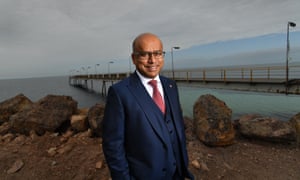UK industrialist’s plan features 780,000 solar panels, generating enough electricity for 96,000 homes
Billionaire UK industrialist Sanjeev Gupta has launched a $1bn,
one-gigawatt renewable energy plan based in South Australia’s mid-north
that he says will lead Australian industry’s transition to more
competitive power.
In the first of a number of projects slated for the upper Spencer Gulf region, which will also include a lithium-ion battery bigger than Elon Musk’s, Gupta’s energy company Simec Zen has released details of its Cultana Solar Farm.
The project will produce 280 megawatts of power and feature 780,000 solar panels, generating enough electricity for 96,000 homes.
“Today’s event is symbolic of our desire to develop and invest in new‐generation energy assets that will bring down Australia’s electricity prices to competitive levels again,” the GFG Alliance boss said as he visited the site near Whyalla on Wednesday.
Other projects in Gupta’s energy blueprint include the lithium-ion battery, expanded solar farms, a co-generation scheme to power his Whyalla steelworks using waste gas, and pumped hydro projects earmarked for the Middleback Ranges.
Gupta said while coal and other fossil-fuels would play an important role in Australia’s energy transition, renewables offered the best future for energy‐intensive industries.
“All of these projects will not only improve reliability and greatly reduce the cost of electricity in our own operations, they will also provide competitive sources of power for other industrial and commercial users, while at the same time playing a key role in the market’s transition towards renewables,” he said.
“We have a strong conviction that traditional carbon‐intensive generation sources do not have a long‐term future as the predominant source of power in Australia and globally.
“We believe the world is undergoing a momentous transition to renewable power as the cost of renewables drops dramatically and quickly.”
Gupta said he had no doubt generations to come would be powered mostly by renewable energy, although the transition would take time and must be phased in carefully.
“Looking forward, we will, therefore, continue to invest in renewables, helping drive their market penetration and continual increase in affordability and reliability,” he said.
“At the same time, we will make use of traditional power sources supporting an orderly transition.”
The South Australian premier, Steven Marshall, said energy security, reliability and affordability were crucial and the government welcomed any investment in generation capacity.
“We believe renewable energy can be an export sector for us out of South Australia,” he said.
Whyalla Mayor Lyn Breuer said Gupta’s vision for the region would lead the rejuvenation of Whyalla in the coming decades.
Final development approval for the new solar farm is expected later this year with construction to begin next year.
In the first of a number of projects slated for the upper Spencer Gulf region, which will also include a lithium-ion battery bigger than Elon Musk’s, Gupta’s energy company Simec Zen has released details of its Cultana Solar Farm.
The project will produce 280 megawatts of power and feature 780,000 solar panels, generating enough electricity for 96,000 homes.
“Today’s event is symbolic of our desire to develop and invest in new‐generation energy assets that will bring down Australia’s electricity prices to competitive levels again,” the GFG Alliance boss said as he visited the site near Whyalla on Wednesday.
Other projects in Gupta’s energy blueprint include the lithium-ion battery, expanded solar farms, a co-generation scheme to power his Whyalla steelworks using waste gas, and pumped hydro projects earmarked for the Middleback Ranges.
Gupta said while coal and other fossil-fuels would play an important role in Australia’s energy transition, renewables offered the best future for energy‐intensive industries.
“All of these projects will not only improve reliability and greatly reduce the cost of electricity in our own operations, they will also provide competitive sources of power for other industrial and commercial users, while at the same time playing a key role in the market’s transition towards renewables,” he said.
“We have a strong conviction that traditional carbon‐intensive generation sources do not have a long‐term future as the predominant source of power in Australia and globally.
“We believe the world is undergoing a momentous transition to renewable power as the cost of renewables drops dramatically and quickly.”
Gupta said he had no doubt generations to come would be powered mostly by renewable energy, although the transition would take time and must be phased in carefully.
“Looking forward, we will, therefore, continue to invest in renewables, helping drive their market penetration and continual increase in affordability and reliability,” he said.
“At the same time, we will make use of traditional power sources supporting an orderly transition.”
The South Australian premier, Steven Marshall, said energy security, reliability and affordability were crucial and the government welcomed any investment in generation capacity.
“We believe renewable energy can be an export sector for us out of South Australia,” he said.
Whyalla Mayor Lyn Breuer said Gupta’s vision for the region would lead the rejuvenation of Whyalla in the coming decades.
Final development approval for the new solar farm is expected later this year with construction to begin next year.

No comments:
Post a Comment